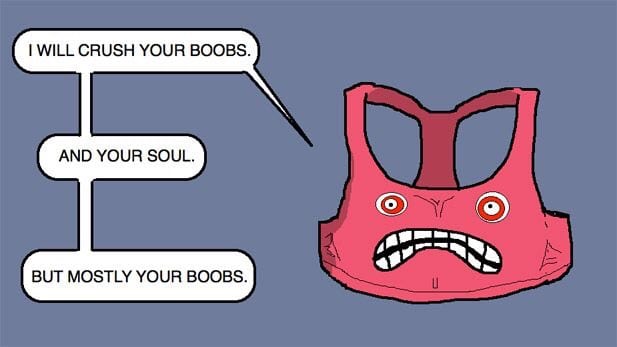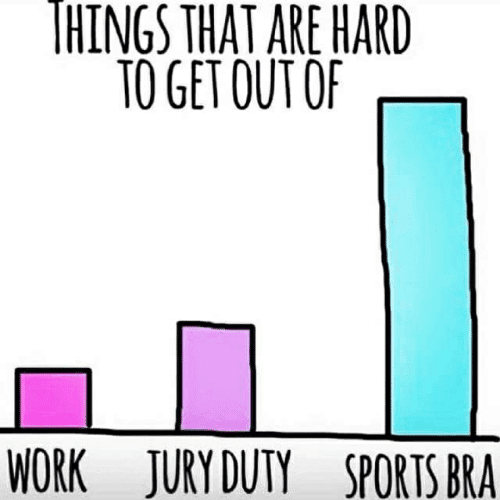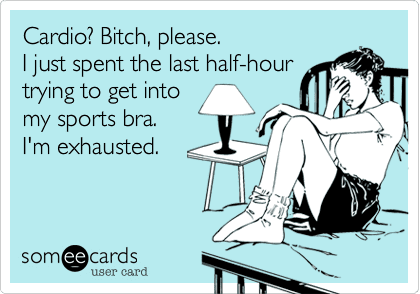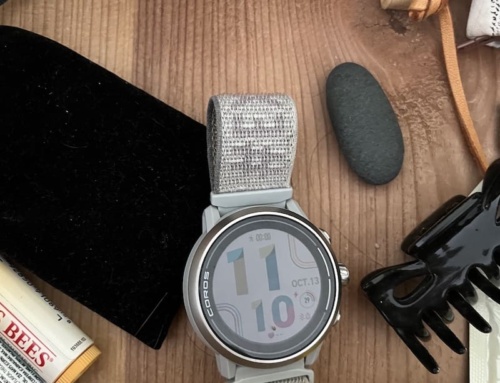Dear Sports Bras,
All we want is for you to hold us up and hold us in without strangling, straight-jacketing or uniboobing us, or coming undone or letting us go (!) and especially without chafing us on the back, in our cleavage, under the straps or under the band.
We’d like to be able to put you on and take you off without having to perform Houdini-esque contortions or worse, getting stuck.
It would be nice if you were cute or at least not embarrassing to behold.
Oh, and also, you should cost less than a new pair of running shoes.
Is that so much to ask?
That’s the $13.8 billion question.
Of course we are grateful we have a billion options, especially when the best are selected and road-tested by AMR testers. (Best for A-C Cups; Best for D+ Cups + Special Circumstances)
 A QUICK HISTORY LESSON
A QUICK HISTORY LESSON
It wasn’t always so. In the early 1970s, women ran in “regular” bras, which were white cotton with flimsy straps. Then a trio of costume-designer running friends, frustrated by the lack of support, sewed together two jock straps as a prototype for what they called the first “JockBra,” mercifully changed to JogBra, for which they received a patent in 1979.

Prototype of the original JogBra, two jock straps sewn together in 1977, at the Smithsonian National Museum of American History.
We may pity-mock the early 1970s lady runners bouncing along in their basic lingerie, but this is a mistake newbies still make, which is understandable as the initial cash outlay seems incomprehensibly high.
When Mother Runner Maggie Hall first started, she says she ran in a “regular” bra, the strap broke and “I had to keep going with one boob flapping.” Oh my! (And then she bought a sports bra, wise woman.)
SOME SLIGHTLY DEPRESSING STATS
But even with a billion options, as recently as 2015, 17% of women didn’t work out because they couldn’t find the right sports bra or were embarrassed by bounce, according to a survey in the Journal of Physical Activity and Health. That’s a 17% shame!
Serious sports-bra-clad women aren’t all that happy either. In a survey of female London marathon participants in 2012, 32% of women reported breast pain (mastalgia). Unsurprisingly, pain was proportionate to size: a problem for 25% of women with A cups but an issue for half of women size F or larger.
This is an important point because there are more women in the larger group today than the smaller one: A 2013 survey found the average American bra size grew (ahem) from 34 B in 1993 to 34 DD in 2013.
 SO WHY IS IT SO HARD TO FIND A PERFECT-FITTING, GIRL-SUPPORTING, NON-CHAFING SPORTS BRA?
SO WHY IS IT SO HARD TO FIND A PERFECT-FITTING, GIRL-SUPPORTING, NON-CHAFING SPORTS BRA?
Rest assured, scientists at are On It (of course they are), notably at the University of Portsmouth Research Group in Breast Health, the first lab to research how movement affects breasts—by filming women running on a treadmill without any support (eek!).
As mother runner Gretchen Reynolds drily explained in a New York Times blog:
“Female breast tissue is unusual, being weighty, even in small-breasted women, but with little natural anatomical support. As a result, unconstrained breasts move independently when a woman does, and that movement is exacerbated during exercise.
Earlier motion-capture research by the Portsmouth scientists established that unsupported female breasts — that is, those not contained within a bra — oscillate as much as eight inches in space when a woman runs, and not just up and down, but also side to side, forward and backward. Even when the volunteers wore a standard sports bra, the scientists found their breasts often continued to sway considerably during running.”
Oscillate eight inches in space and not just up and down but also side to side, forward and backward. Oh my!
That’s a lot of work for a little bit of fabric.
For Outside Online, reporter Heather Hansman spoke to University of Portsmouth researcher Michelle Norris and revealed the secret to the best sports bra fit:
“In the lab, Norris found that the underband is more important than the straps, and bras that incorporate both encapsulation (separate cups) and compression (holding them tight to your chest) tend to reduce movement while still letting the wearer breathe. The best bounce reduction they’ve seen in the lab is 72%.”
Ok, we get it; as LaJean Lawson, Dr. Sports Bra, in our podcast this week tells us, “Sports bras are the hardest piece of clothing to engineer.”
Let’s take fit out of it: What about some other universal sports bra problems?
SOLUTIONS FOR CHAFE + HIGH PRICES
We can’t really help with the over-the-head wrestle, but we do have some other good ideas.
As for shower-shrieking chafing, BodyGlide is the obvious first line of defense. Renee Place-Eron likes Squirrel Nut Butter. And Rachel Becker Powell suggests using KT Tape, both under the ribcage and under straps on the back. Moleskin is another life of defense.
To get around the expensive expense, some buy from online resellers Poshmark or eBay, though that makes me feel a little leery about quality control. Grabbing discounted styles at Sierra Trading Post and the Clymb are also good options.
Or you can follow #motherruner Andrea Kelly Briggeman’s lead; she keeps costs down by buying bras once a year, when her local lingerie shop gives a discount during her birthday month. Nice!
Are those removable pads your problem? Reality Moms hears you.
GET THAT BRA TO LAST AND LAST
The industry party line says a sports bra lasts 6 months to a year, or about the life of a pair of running shoes. Heather Cvitkovic, director of apparel merchandising at Brooks Running Company, recommends extending sports bras’ life by having three bras in rotation, wearing them for more than one run before washing (as long as they don’t stink too much) and line-drying them.
Here is a handy guide to know when your sports bra is worn out, courtesy of Fleet Feet.
- Straps sliding. If the straps of your bra are sliding around, coming off your shoulders during exercise or you can’t adjust them like you want to, they’re likely worn out.
- Chafing around the band. Your bra’s band will stretch out and loosen as it ages. If you start to experience chafing around your midsection, it could be because the band is moving around as you work out.
- Color changes. Has your light-colored bra turned yellow-ish? Has the color faded or dulled? It’s time to buy a new bra if your current rig undergoes a noticeable color change.
- Fraying. Frayed edges or exposed clasps can lead to irritation and are another sign that it’s time to replace a bra.
- Worn out elastic. Tug on the straps and the bottom band. If they don’t rebound or you don’t feel any resistance, it’s past its prime.
What all this tells me is … it’s time for me to order some new sports bras! Sigh.


 A QUICK HISTORY LESSON
A QUICK HISTORY LESSON SO WHY IS IT SO HARD TO FIND A PERFECT-FITTING, GIRL-SUPPORTING, NON-CHAFING SPORTS BRA?
SO WHY IS IT SO HARD TO FIND A PERFECT-FITTING, GIRL-SUPPORTING, NON-CHAFING SPORTS BRA?




Oh man. I have like 10 sports bras in my rotation. Depends on the Run or workout I’m doing for which one I wear. About a year ago I bought al new bras. Found one I liked from Lululemon on the clearance rack and then bought it in every color!
I have one- under armor and have had it for about 5-6 years. It’s held up pretty good considering the wear and washing it gets in one week (Sometimes I wear for cycling also)- coming from pre-sports bra days and usually ending up running in a bathing suit top or a one piece suit for years, I find that my push ups and bench presses and other pec exercises help keep the “girls” from going flat and bouncing around….just ordered a moving comfort I found on sale. Hope it “works”. I have never had chafing problems
I have 4 Nike bras they have been the best for me so far. I make sure to buy as many as I can every 6 months in my size when I get to go to the company store so they are 1/2 price! I get rid of the ones I have had for a year when I buy the new ones. I always hang dry and they seem to last for a year.
I have several, but most of them are at least five years old. I don’t understand why you need to get rid of a bra if the color changes or just because six months have passed? I’m smaller chested and don’t experience pain, so maybe that is why I don’t get it? Are smaller chested ladies exempted from these rules as long as they are running pain-free?
My sports bras are probably at least 4-5 years old and I have maybe about 7. I found one Nike one I really liked and just stuck with it and unfortunately I cannot find it anymore. I hesitate putting down money on something I may wear once and not again if I don’t like it. Also shopping for sports bra is just annoying! After reading this maybe I just need to suck it up buttercup and get some new ones since mine are old.
I don’t have a sports bra I love, the best for me at the moment is Brooks Juno – I’m a 32C and 54. I will say I find it more difficult to find a decent bra now that I’ve gone through menopause. The breast simply are not as dense and seem to move more, sorry if TMI. I’ve tried various Lululemon bras and there is too much bounce – not that I feel the bounce but I certainly see if. Based on the bra recommendations here I’ve ordered two Sweaty Betty bras to try. Over the years I’ve tried every bra anyone mentioned and didn’t love any of them. Typically cute scrappy doesn’t support. I run between 35-40 miles a week. I can tell you on my long run days I see lots of women running and very few, if any, seem to be wearing a supportive bra and it doesn’t seem to have anything to do with size. I joke to my husband I should wear a body cam one day and put it on youtube.
I have a collection, with many being Target or TJ Max buys. They are all aging. I was in cold water and always hang dry. I suspect my bras don’t work as hard since I’m flat chested….I am eyeballing a bra with pockets up front, as it is on sale (North Face stow n go). Will see if the name brand feels any different.